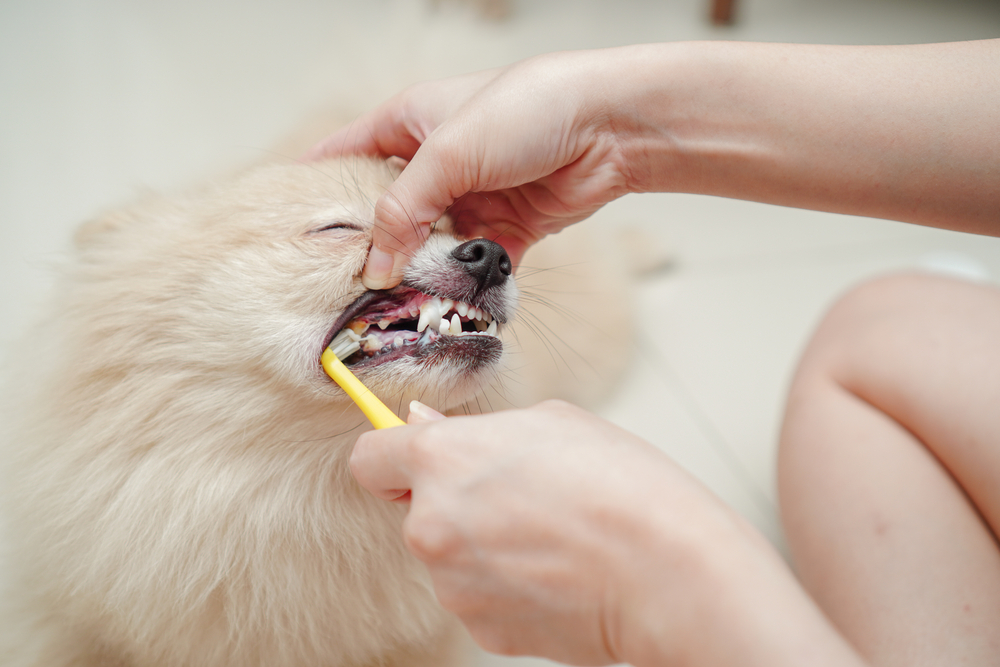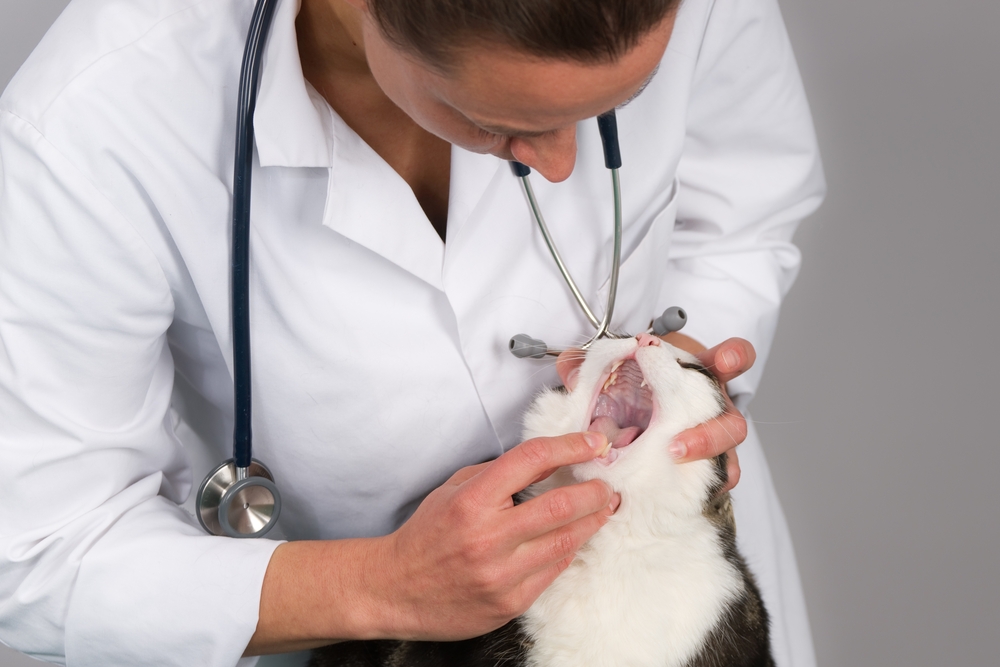Your pet’s good dental health is vital for her general well-being, yet many owners ignore their pet’s needs for dental care. More than 70% of pets have developed dental problems by age 3, and the consequences of those problems, such as heart, liver, and kidney disease, can be life-threatening. However, dental disease can be prevented, ideally with an at-home daily toothbrushing regimen, as well as professional teeth cleanings at our clinic.
Read the following conversation between Jessica and her pet, Tiny Tim, for a lesson on the importance of maintaining your pet’s good dental health.
Jessica: OK, Tiny Tim. Let’s give toothbrushing a try, since your veterinarian, Dr. Rexing, says it’s absolutely necessary. Hmmm … this may be difficult, so I think I will take a quick nap first.
Jessica lies down, and Tiny Tim snuggles with her. Jessica falls into a deep sleep and starts dreaming about brushing her pet’s teeth. Strangely, she hears Tiny Tim’s new toothbrush talking to one of his teeth.
Tooth: Excuse me. Who are you, and why are you here in Tiny Tim’s Mouth?
Toothbrush: My name is Toothbrush, but my friends call me Rush. Who are you?
Plaque, tartar, and disease
Tooth: My name is Right Maxillary Canine, but my family calls me Maxine. Wake up Tiny Tim’s Tooth Team—we have a visitor. His name is Rush. As you can see, we were not expecting a visitor. We never cleaned Tiny Tim’s mouth after his last meal, so please excuse the mess and the smell. Why are you here?
Rush: Do you feel that thin, colorless stuff sticking to you? It’s called plaque, and it’s disgusting. It’s formed by the bacteria in Tiny Tim’s mouth, but it can easily be rubbed off by a toothbrush like me, or when Tiny Tim eats kibble, or plays with a chew toy.
Maxine: That’s what that sticky stuff is? It seems like no matter what I do, it keeps coming back. What happens if you don’t get all the plaque off?
Rush: The plaque turns into another substance called calculus, or tartar, which is as hard as the mathematics with the same name. It’s a big problem, because it won’t come off easily. It needs Tiny Tim’s veterinary team, and their special tools.
Rush: There’s more. Tartar can cause more problems, because the bacteria can burrow down under the gumline, where 60% of each tooth is hidden, and cause serious problems, including an infection called gingivitis.
Maxine: Is gingivitis the redness that surrounds me and my fellow teeth at the gumline?
Rush: Yes. Bacteria also will destroy the connection between the teeth and the gums, and can cause teeth to become loose, and possibly fall out. The bacteria can also get underneath or inside the teeth and cause significant pain.
Maxine: Several of us have been really painful, with no idea why. Last week, the gum around us became red and warm, and Tiny Tim’s breath smelled terrible. Then, the pain hit. We lost an incisor, too—it was heartbreaking.
At-home prevention of plaque and other problems
Rush: I am so sorry to hear that. Also, it’s sad to say, but Jessica would not have been aware of the pain Tiny Tim was suffering because of your fellow teeth, because dogs seldom show pain. They will walk around, and eat, with painful, loose teeth until any dental disease has really advanced. Pet parents like Jessica won’t know something is wrong, and they can’t fix a problem they don’t know about.
Maxine: That’s terrible! What can Jessica do to protect us from such a fate?
Rush: That’s why I am here. When Jessica uses me to brush Tiny Tim’s teeth, I not only remove most of the plaque on his teeth, but I also stimulate blood flow in the gums, and the blood will take immune cells into the gums and fight off bacterial infection.
Maxine: My hero! How often will we get to see you, Rush?
Rush: At least three times per week, although daily is better to take care of you all. I will likely have on some pet-specific toothpaste, and Jessica may also use some oral gels or additives in Tiny Tim’s food or water to take care of you at a higher level.
Maxine: This tooth family wants to be really healthy. What else can Jessica do to help us, and Tiny Tim, thrive?
Rush: Tiny Tim can also show Jessica the Veterinary Oral Health Council website, where pet owners can look for products like dental diet food and treats proven to fight plaque and tartar.
Going the extra (professional) mile for dental disease
Maxine: Wowsers, and what about the tooth family members that are painful now? Can Jessica help them, and Tiny Tim, if she doesn’t realize there’s a problem?
Rush: You bet! The best thing Jessica can do is schedule Tiny Tim for a professional dental examination and cleaning immediately, and then every year. He needs his veterinarian to thoroughly assess his mouth, take dental X-rays to find problem teeth they can’t see without X-rays, and then deal with any loose, painful teeth.
Maxine: I think most of this tooth family would love a yearly deep cleaning, but isn’t all that scary for Tiny Tim?
Rush: Tiny Tim doesn’t need to be scared, and Jessica doesn’t need to worry, because professional cleanings are always done under anesthesia to ensure the pet stays still, and doesn’t suffer any pain or anxiety. And now, if it’s alright with you, I need to get to work brushing you and your family.
Jessica wakes up.

Jessica: I’m not sure how my subconscious knew all that helpful information, but now that I understand why brushing Tiny Tim’s teeth is so important, I will do it religiously. Come here, Tiny Tim.
Does your pet need her first, or annual, professional dental cleaning? Call our hospital for an appointment, and help ensure your pet’s optimal dental health and general wellbeing.







Leave A Comment